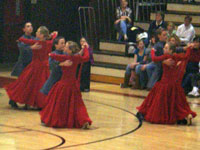
The Waltz
 Birthplace: Vienna Austria
Birthplace: Vienna Austria
Creation date: mid 1600
Dance type: American Smooth
The elegant waltz is considered the queen of all ballroom dances. The waltz has the longest history of any of the dances, having roots that date back to the 16th century. The waltz that we now dance appeared in Austria sometime in the 18th century as the "Viennese Waltz." This waltz was a fast turning dance that moved around the room in a circular direction. This new-found freedom of movement was a welcome change to the spatially restrictive other dances. As the dance evolved, it became slower and added hesitations and other patterns.
The waltz reached a zenith of popularity it the 19th century across Europe and in America. Many composers, most notable Johann Straus, and his sons, began composing began composing music especially for the waltz. Dance bands were formed out of larger orchestras. All classes of society loved this romantic dance that was a contrast to the stiff minuets and confining cotillion dances. However, the waltz created quite a stir in the genteel society because of the shocking intimacy of its closed dance position. Before the waltz entered the ballrooms of the world, all dances were done side by side with only hand-to-hand-positions.
Early patterns of the waltz consisted of not more than a right turn, left turn, and a change of direction. After the 1920's, many more variations were introduced and standardized by the Imperial Society of Teachers of Dancing (ISTD). Most of these patterns are still danced today.
Most social dancers feel that a dance isn't complete until they have had a waltz. The most memorable moment at many wedding receptions is when a bride waltzes with her father.
This work is credited to BYU-Idaho dance book 2006.
Call Kevin Hunter 208-870-6737 EMail: captindanceman@yahoo.com















